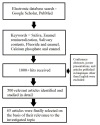The role of salivary contents and modern technologies in the remineralization of dental enamel: a narrative review
- PMID: 32201577
- PMCID: PMC7076334
- DOI: 10.12688/f1000research.22499.3
The role of salivary contents and modern technologies in the remineralization of dental enamel: a narrative review
Abstract
Human enamel once formed cannot be biologically repaired or replaced. Saliva has a significant role in remineralization of dental enamel. It not only has a buffering capacity to neutralize the oral cavity's low pH generated after acidic encounters, but also acts as a carrier of essential ions, such as fluoride, calcium and phosphate, which have a positive role in enamel's remineralization. This review discusses how salivary contents, like proteins and enzymes, have a natural role in enamel's mineralization. In addition, the presence of ions, such as fluoride, calcium and phosphate, in saliva further enhances its capability to remineralize the demineralized enamel surface. The review further examines modern innovative technologies, based on biomimetic regeneration systems, including dentin phosphoproteins, aspartate-serine-serine, recombinant porcine amelogenin, leucine-rich amelogenin peptide and nano-hydroxyapatite, that promote enamel remineralization. Fluoride boosters like calcium phosphates, polyphosphates, and certain natural products can also play an important role in enamel remineralization.
Keywords: Calcium Phosphate; Enamel; Fluoride; Remineralization; Saliva.
Copyright: © 2021 Farooq I and Bugshan A.
Conflict of interest statement
No competing interests were disclosed.
Figures


Similar articles
-
Amelogenin-inspired peptide, calcium phosphate solution, fluoride and their synergistic effect on enamel biomimetic remineralization: an in vitro pH-cycling model.BMC Oral Health. 2024 Feb 27;24(1):279. doi: 10.1186/s12903-024-04008-z. BMC Oral Health. 2024. PMID: 38413983 Free PMC article.
-
Controlled remineralization of enamel in the presence of amelogenin and fluoride.Biomaterials. 2009 Feb;30(4):478-83. doi: 10.1016/j.biomaterials.2008.10.019. Epub 2008 Nov 8. Biomaterials. 2009. PMID: 18996587 Free PMC article.
-
In situ clinical effects of new dentifrices containing 1.5% arginine and fluoride on enamel de- and remineralization and plaque metabolism.J Clin Dent. 2013;24 Spec no A:A32-44. J Clin Dent. 2013. PMID: 24156138 Clinical Trial.
-
Anticariogenicity of casein phosphopeptide-amorphous calcium phosphate: a review of the literature.J Contemp Dent Pract. 2009 May 1;10(3):1-9. J Contemp Dent Pract. 2009. PMID: 19430620 Review.
-
Advanced non-fluoride approaches to dental enamel remineralization: The next level in enamel repair management.Biomater Biosyst. 2021 Oct 29;4:100029. doi: 10.1016/j.bbiosy.2021.100029. eCollection 2021 Dec. Biomater Biosyst. 2021. PMID: 36824571 Free PMC article. Review.
Cited by
-
Activity and levels of TNF-α, IL-6 and IL-8 in saliva of children and young adults with dental caries: a systematic review and meta-analysis.BMC Oral Health. 2024 Jul 18;24(1):816. doi: 10.1186/s12903-024-04560-8. BMC Oral Health. 2024. PMID: 39026257 Free PMC article.
-
Evaluation of Children Caries Risk Factors: A Narrative Review of Nutritional Aspects, Oral Hygiene Habits, and Bacterial Alterations.Children (Basel). 2022 Feb 15;9(2):262. doi: 10.3390/children9020262. Children (Basel). 2022. PMID: 35204983 Free PMC article. Review.
-
Comparison of microleakage under orthodontic brackets bonded with five different adhesive systems: in vitro study.BMC Oral Health. 2023 Sep 5;23(1):637. doi: 10.1186/s12903-023-03368-2. BMC Oral Health. 2023. PMID: 37670283 Free PMC article.
-
In Vitro Cytotoxicity Evaluation of Nanosized Hydroxyapatite and Fluorapatite on Cell Lines and Their Relevance to the Alveolar Augmentation Process.J Funct Biomater. 2025 Apr 2;16(4):125. doi: 10.3390/jfb16040125. J Funct Biomater. 2025. PMID: 40278233 Free PMC article.
-
Amelogenin-inspired peptide, calcium phosphate solution, fluoride and their synergistic effect on enamel biomimetic remineralization: an in vitro pH-cycling model.BMC Oral Health. 2024 Feb 27;24(1):279. doi: 10.1186/s12903-024-04008-z. BMC Oral Health. 2024. PMID: 38413983 Free PMC article.
References
Publication types
MeSH terms
Substances
LinkOut - more resources
Full Text Sources

